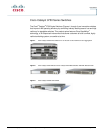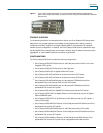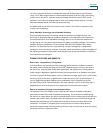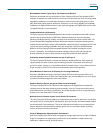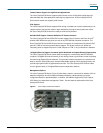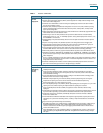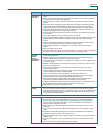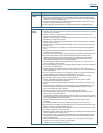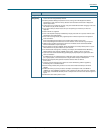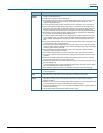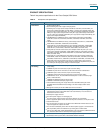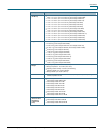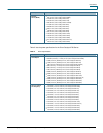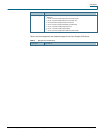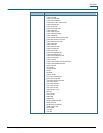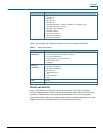
Data Sheet
All contents are Copyright © 1992–2006, 2008 Cisco Systems, Inc. All rights reserved. This document is Cisco Public Information. Page 7 of 23
Feature Benefit
High-
Performance
IP Routing
●
Cisco Express Forwarding hardware routing architecture delivers extremely high-performance IP
routing.
●
Basic IP unicast routing protocols (static, Routing Information Protocol Version 1 [RIPv1], and RIPv2)
are supported for small-network routing applications.
●
IPv6 routing support in hardware for maximum performance. The Advanced IP Services License is
required.
●
Advanced IP unicast routing protocols (Open Shortest Path First [OSPF], Interior Gateway Routing
Protocol [IGRP], Enhanced IGRP [EIGRP], and Border Gateway Protocol Version 4 [BGPv4]) are
supported for load balancing and constructing scalable LANs. The IP Services image is required.
●
Policy-based routing (PBR) allows superior control by facilitating flow redirection regardless of the
routing protocol configured. The IP Services image is required.
●
HSRP provides dynamic load balancing and failover for routed links; up to 32 HSRP links supported
per unit or stack.
●
Inter-VLAN IP routing for full Layer 3 routing between 2 or more VLANs.
●
Protocol Independent Multicast (PIM) for IP multicast routing is supported, including PIM sparse mode
(PIM-SM), PIM dense mode (PIM-DM), and PIM sparse-dense mode. The IP Services image is
required.
●
Distance Vector Multicast Routing Protocol (DVMRP) tunneling interconnects 2 multicast-enabled
networks across nonmulticast networks. The IP Services image is required.
●
Fallback bridging forwards non-IP traffic between 2 or more VLANs. The IP Services image is
required.
●
Routing is possible across the stack.
●
128 switch virtual interfaces (SVIs) are recommended. Maximum of 1000 are supported (depending on
the number of routes and multicast entries). 468 routed ports are supported per stack.
Integrated
Cisco IOS
Software
Features
for Bandwidth
Optimization
●
Per-port broadcast, multicast, and unicast storm control prevents faulty end stations from degrading
overall systems performance.
●
IEEE 802.1d Spanning Tree Protocol support for redundant backbone connections and loop-free
networks simplifies network configuration and improves fault tolerance.
●
PVST+ allows for Layer 2 load sharing on redundant links to efficiently use the extra capacity inherent
in a redundant design.
●
IEEE 802.1s Multiple Spanning Tree Protocol allows a spanning-tree instance per VLAN, for Layer 2
load sharing on redundant links.
●
Equal-cost routing facilitates Layer 3 load balancing and redundancy across the stack. The IP
Services image is required.
●
Local Proxy Address Resolution Protocol (ARP) works in conjunction with Private VLAN Edge to
minimize broadcasts and maximize available bandwidth.
●
VLAN1 minimization allows VLAN1 to be disabled on any individual VLAN trunk link.
●
VLAN Trunking Protocol (VTP) pruning limits bandwidth consumption on VTP trunks by flooding
broadcast traffic only on trunk links required to reach the destination devices.
●
Internet Group Management Protocol (IGMP) snooping provides fast client joins and leaves of
multicast streams and limits bandwidth-intensive video traffic to only the requestors.
●
Multicast VLAN Registration (MVR) continuously sends multicast streams in a multicast VLAN while
isolating the streams from subscriber VLANs for bandwidth and security reasons.
●
Up to 48 EtherChannel groups are supported per stack.
Scalable
Stacking
●
Cisco StackWise stacking creates a 32-Gbps switch interconnection. Stacking does not require user
ports. Up to 9 units can be stacked together for a maximum of 468 10/100 ports, 468 10/100/1000
ports, 108 optical aggregation ports, nine 10 Gigabit Ethernet ports, or any mix thereof. Additional port
combinations can be created by stacking together the Cisco Catalyst 3750 Series Switches and the
Cisco Catalyst 3750-E Series Switches.
QoS and Control
Advanced QoS
●
Cross-stack QoS allows QoS to be configured across the entire stack.
●
802.1p class of service (CoS) and differentiated services code point (DSCP) field classification is
provided, using marking and reclassification on a per-packet basis by source and destination IP
address, source and destination MAC address, or Layer 4 Transmission Control Protocol/User
Datagram Protocol (TCP/UDP) port number.
●
Cisco control-plane and data-plane QoS ACLs on all ports help ensure proper marking on a per-
packet basis.
●
4 egress queues per port help enable differentiated management of up to 4 traffic types across the
stack.
●
Shaped Round Robin (SRR) scheduling helps ensure differential prioritization of packet flows by
intelligently servicing the ingress queues and egress queues.
●
Weighted Tail Drop (WTD) provides congestion avoidance at the ingress and egress queues before a
disruption occurs.
●
Strict priority queuing helps ensure that the highest-priority packets are serviced ahead of all other
traffic.
●
There is no performance penalty for highly granular QoS capability.



